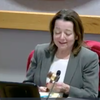As Schumer calls for FBI ‘cyber super SWAT team,’ GCSD develops plan for reacting to potential swatting
GUILDERLAND — “‘Swatting’ is a new vocabulary word,” Superintendent Marie Wiles told Guilderland School Board members at their April 4 meeting.
“It’s essentially an approach that some very ill-intentioned people are using to create chaos through the lens of our first responders,” said Wiles. “So they initiate calls, often through a 9-1-1 center, that makes first responders jump to action because there is an alleged active shooter or bomb scare or hostage situation.”
Although the Guilderland schools did not experience any swatting calls in recent weeks, a number of local schools, as well as schools across the state and nation, did.
The term “swatting” was used by the Federal Bureau of Investigation as early as 2008. The FBI in February of that year wrote about “The New Phenomenon of ‘Swatting’,” detailing a group that had caused sports events and hotels to be evacuated because of fake bomb threats.
The FBI described swatting as “calling 9-1-1 and faking an emergency that draws a response from law enforcement — usually a SWAT team.”
A SWAT team is a special weapons and tactics team called to high-risk situations.
The five swatters in the 2008 incidents were arrested by the FBI’s Dallas office, working with law-enforcement agencies in various parts of the country.
Kevin Kolbye, assistant special agent in charge of the Dallas office, asked why the crime had been committed, said at the time, “Individuals did it for the bragging rights and ego, versus any monetary gain.”
“Basically, they did it because they could,” the FBI piece concluded.
On Monday, Senator Charles Schumer, the Senate’s majority leader, held a press conference in front of Troy High School, which had been swatted, calling for the FBI to comprehensively investigate swatting incidents at schools.
“This is not just a victimless crime,” said Schumer, adding of the petrified teachers and students, “The trauma does not go away.”
Schumer said that last week police had to go to over 220 schools because of the false threats, stretching resources thin for local first responders.
While swatting has been around for a while, Schumer said, it used to be rare. “These recent attacks are unprecedented,” he said, noting a particular concentration in the Capital Region.
“We eventually can find out where the swatters are but there is no guarantee and perhaps not even a likelihood they are from the Capital Region, that they’re even from New York State, that they’re even from America, from the U.S.,” said Schumer.
Hence, he said, a federal approach should be used to crack the cases. He said he would push to secure $10 million for the FBI in a three-pronged approach. The first is the FBI would launch a full-scale investigation. The second prong would be computer and cyber work, which would be systemic rather than ad hoc.
The third prong would be to track all the school swatting incidents in the last several years to put together a comprehensive dossier to see where similar patterns and techniques are used.
“They don’t track them now,” Schumer said of the FBI.
Schumer said of the perpetrators, noting a call could have been bounced from Budapest through Canada to New York, “They hide where the computer is. The FBI can pierce that but it takes some time, some energy, and some dollars.”
The $10 million will create “a cyber super SWAT team,” Schumer concluded.
Meanwhile, at Guilderland, Wiles said that, in the wake of other schools being plagued with recent swatting threats, administrators had met with Guilderland Police Chief Daniel McNally as well as the district’s two school resource officers and others “to talk about what should be our approach.”
Wiles told the school board, “The short answer is: We have some guidelines. I’m not going to spell them out right now for security reasons.
“So we have a plan of what we would do, recognizing that these plans sometimes need to be informed by judgment of the particular circumstances.”
Wiles said that area superintendents, after spring break, would be taking up the topic.
“It’s a security issue. It’s a communications issue,” she said. “You know, we don’t want to inspire copycats to disrupt the school day. So it really is a terrible set of circumstances that we’re in right now.”
At the April 4 meeting, Wiles also highlighted “the safety and security enhancements” made by the district over the last several years.
This includes the installation of protective film on exterior entrance door windows on all school buildings to prevent glass from shattering; an improved camera system; a district-wide radio system with a direct tie to first responders and the Guilderland Police; and LED light displays and public-address speakers in student-occupied spaces for shelter-in-place lockouts and lockdowns.
“We do maintain our steadfast commitment to the safety and well being of each and every one of our students and our staff,” said Wiles, concluding, that safety is “just something we absolutely have to have front of mind each and every day.”
Other business
In other business at its April 4 meeting, the Guilderland School board:
— Accepted, without discussion, by a vote of 8 to 0, the resignation of Migdalia Young, effective Sept. 23, 2023, and approved a March 28 agreement between Young and the district, which the superintendent is to execute on behalf of the district.
Young is an English teacher at Farnsworth Middle School, who has worked for the district since 2009;
— Voted, 6 to 2, without discussion, to deny homebound instruction for a student who had made an appeal. The six board members who approved the denial were Rebecca Butterfield, Katie DiPierro, Kelly Person, Seema Rivera, Nathan Sabourin, and Judy Slack.
Kim Blasiak and Blanca Gonzalez-Parker opposed the denial. Gloria Towle-Hilt was absent;
— Awarded a private-transportation contract to Rejha Group as the lowest responsible bidder at $3 per mile and $33,750 in annual costs for transport to two learning centers;
— Heard from Assistant superintendent for curriculum and Instruction Rachel Anderson that a number of students had artwork selected for the 29th Annual High School Regional Juried Art Exhibition at the Albany Center Gallery: Evalyse Peralta, Shruthika Manga, Renee Manzella, Nicolena Rush, Amelia Boswell-Penc, Jaden Smith, Emily Salisbury, and Kylie Ocasio. Peralta received a Juror’s Choice Award.
Anderson congratulated the students as well as their teachers: Sarah Gockley, Shannon O’Mahony, and Kyle Greene; and
— Heard from Anderson that Guilderland’s Science Olympiad Club competed in the Feb. 4 Capital Region Competition involving 20 teams. Guilderland participated in 10 events and received medals in five of the events: Chemistry Lab: 5th Place by Will Smitas (10) and Faruk Yilmaz (11); Codebusters: 4th Place by Isabella Wu (10), Jeanne Lu (10), and Angelina Mantoo (9); Dynamic Planet: 3rd Place by Liam Melchior (11) and Zexi “John” Wang (9); Fermi Questions: 5th Place by Will Smitas (10) and Faruk Yilmaz (11); and Rocks and Minerals: 6th Place by Andrew Wu (11) and Aakash Iyer (11).



